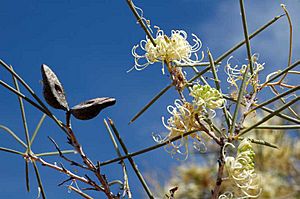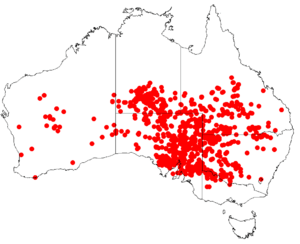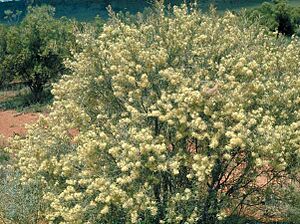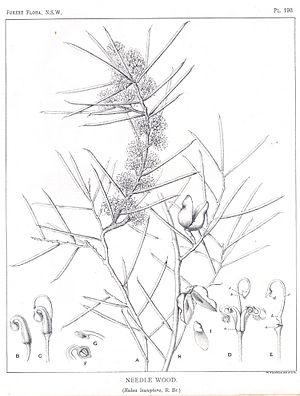Silver needlewood facts for kids
Quick facts for kids Silver needlewood |
|
|---|---|
 |
|
| Hakea leucoptera growing west of Wanaaring, New South Wales | |
| Scientific classification | |
| Genus: |
Hakea
|
| Species: |
leucoptera
|
 |
|
| Occurrence data from AVH | |
Hakea leucoptera, also known as silver needlewood or water tree, is a special plant from Australia. In the Koori language, it's called booldoobah. This plant can be a small shrub or a small tree. It has stiff, pointy leaves that look like needles. Its flowers are white, cream, or yellow and bloom in late spring and early summer. You can find Hakea leucoptera all over central Australia.
Contents
What Does Silver Needlewood Look Like?
This plant can grow in different ways. It might be a small tree up to 5 m (20 ft) tall with open branches. Or it could be a smaller shrub, about 3 m (10 ft) tall, with many stems. It often grows in sandy soils and is found in woodland areas. You can see it across many parts of mainland Australia. It can grow in thick groups or as single trees with smaller plants around them. The wood is reddish-brown and becomes hard and brittle when dry.
Leaves and Flowers
The leaves of the silver needlewood are a shiny silver-grey or blue-grey. They grow one after another along the stems. These leaves are stiff and shaped like cylinders. They can be from 8–35 mm (0.3–1 in) long and about 1.5 mm (0.06 in) wide. Each leaf has a very sharp, pointed tip. Young leaves feel a bit fuzzy, but they become smooth as they get older.
Pretty creamy-white flowers grow in groups of 20 or more. They are on short, smooth stalks about 4 mm (0.2 in) long. Hakea leucoptera flowers from late spring all the way into summer.
Fruits and Seeds
After flowering, the plant forms woody fruits called follicles. These fruits are about 20–30 mm (0.8–1 in) long. They are wider at the bottom and get narrower to a point. When the fruit is ready, it splits open into two halves. Inside, you'll find two seeds. Each seed has a clear wing on one side.
The woody seed pods can stay on the branches for a long time, even after the next year's flowers bloom. It's best to collect older fruits because immature seeds won't ripen if picked too early. The number of fruits can change each year. Once picked, the fruits usually dry out and open in about one to two weeks. This plant is easy to grow from fresh seeds, which usually sprout in 3 to 6 weeks. You can even plant the seeds directly into the ground.
Naming the Silver Needlewood
The plant Hakea leucoptera was first officially described in 1810 by a botanist named Robert Brown. The name leucoptera comes from two ancient Greek words: leukos, meaning "white", and pteron, meaning "feather" or "wing". This probably refers to the clear, wing-like part of the seeds.
Hakea leucoptera belongs to a group of plants called the Sericea group. These plants usually have simple, round leaves, only a few flowers, and woody fruits. Other plants in this group include H. sericea and H. tephrosperma.
Where Does Silver Needlewood Grow?
You can find Hakea leucoptera in every state of Australia except Tasmania. It is very common in dry and semi-dry areas of the country.
Amazing Uses of Silver Needlewood
This plant has been very important, especially to the Indigenous people of Australia and early explorers.
A Source of Water
One of its most amazing uses was as a source of water! People could get water from the roots of the tree. They would burn the tree, which pushed water into the root system. Then, they would dig up the roots. They would strip the roots and place one end over a slow fire. The other end would be placed over a container, and the heat would force the water out. This special ability also helped the plant grow back quickly after a fire.
Food and Medicine
- A sweet and healthy drink could be made by dipping the flowers into a cup of water or by sucking the flowers directly.
- The flowers of Hakea leucoptera produce high-quality honey that bees love.
- Indigenous people also used parts of the Hakea tree as medicine. They would apply burnt bark directly to burns and open sores. Sometimes, they mixed the burnt bark with animal fat to make a healing ointment.
Other Uses
- The woody seed pods were used by Indigenous people for decoration.
- The timber from the tree polishes well and has a beautiful grain. It was used to make small leather items.
- In 1895, a company in Sydney even made smoking pipes from the roots of this plant!
More About Hakeas
Hakeas are part of the plant family called Proteaceae. This family also includes other well-known Australian plants like Banksias, Grevilleas, and Waratahs.
There are about 150 different types of Hakeas, and they are only found in Australia. They grow in many different places, from dry deserts to forests and even swampy areas.
Many Hakeas have narrow, pointy leaves, which is why they are often called "needle bush." This shape helps them survive in dry places. The small leaf surface means less water is lost from the plant.
Most Hakeas are shrubs, but some are low-growing groundcover plants, and others can be small trees up to 10 metres tall. Their flowers look similar to those of their close relatives, the Grevilleas.
A key difference between Hakeas and Grevilleas is that Hakeas have woody fruits. These fruits open into two halves to release two seeds, each with a thin, wing-like part. The seeds fit neatly into spaces in the woody case. Many of these seed cases are quite decorative and can have interesting shapes or bumpy textures. Some Hakeas even have long flower clusters, up to 20 centimetres long.




